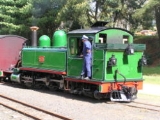
Narrow gauge lines of the Victorian Railways
Encyclopedia
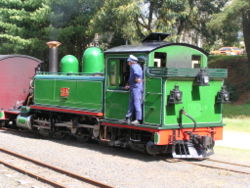
Victorian Railways
The Victorian Railways operated railways in the Australian state of Victoria from 1859 to 1983. The first railways in Victoria were private companies, but when these companies failed or defaulted, the Victorian Railways was established to take over their operations...
, the state railway authority in Victoria
Victoria (Australia)
Victoria is the second most populous state in Australia. Geographically the smallest mainland state, Victoria is bordered by New South Wales, South Australia, and Tasmania on Boundary Islet to the north, west and south respectively....
, Australia
Australia
Australia , officially the Commonwealth of Australia, is a country in the Southern Hemisphere comprising the mainland of the Australian continent, the island of Tasmania, and numerous smaller islands in the Indian and Pacific Oceans. It is the world's sixth-largest country by total area...
built a number of experimental 2 in 6 in (762 mm) narrow gauge railway lines around the beginning of the 20th century. Although all were closed by the early 1960s, parts of two have been reopened as heritage railways.
Background
A depression in the early 1890s brought a halt to the rapid expansion of railways in Victoria. Politicians promoted narrow gauge lines as a way to link remote communities, particularly in hilly country, without the expense of the 5 in 3 in (1,600.2 mm) broad gaugeBroad gauge
Broad-gauge railways use a track gauge greater than the standard gauge of .- List :For list see: List of broad gauges, by gauge and country- History :...
railways. Railways officials opposed them, citing the inconvenience and expense of a break-of-gauge
Break-of-gauge
With railways, a break-of-gauge occurs where a line of one gauge meets a line of a different gauge. Trains and rolling stock cannot run through without some form of conversion between gauges, and freight and passengers must otherwise be transloaded...
. A parliament
Parliament of Victoria
The Parliament of Victoria is the bicameral legislature of the Australian state of Victoria. It follows a Westminster-derived parliamentary system and consists of The Queen, represented by the Governor of Victoria; the Legislative Council ; and the Legislative Assembly...
ary committee eventually identified 14 possible locations for narrow gauge railways, and recommended that four experimental lines be built. They were:
- Lilydale – Warburton
- Wangaratta – Whitfield
- Upper Ferntree Gully – Gembrook
- Colac – Beech Forest
The Warburton line was built in broad gauge, however authority was given for the construction of the other three lines. Subsequently, a further two lines were built, the Moe to Walhalla line, and an extension from Beech Forest to Crowes. At various times other lines and extensions were proposed, but none came to anything.
Initial plans were for the railways to be constructed in 2 ft (610 mm) gauge, but following correspondence with British railway engineer Everard Calthrop
Everard Calthrop
Everard Richard Calthrop was a British railway engineer and inventor. Calthrop was a notable promoter and builder of narrow gauge railways, especially of gauge, and was especially prominent in India. His most notable achievement was the Barsi Light Railway; however he is best known in his home...
, amongst others, a change was made to 2 in 6 in (762 mm) gauge.
None of the lines constructed ever made a profit. Freight rates were the same for broad and narrow gauge railways, despite higher direct costs. Most of the loadings were goods such as timber, potatoes and lime, which were charged at a low rate. Most freight was outbound, so many trains travelled towards the terminals almost empty. And despite originating the traffic, the lines were only credited with a portion of the freight charge. The amount credited to the lines did not cover the cost of running trains, and the more traffic the larger the loss. However, particularly in the 1920s, the traffic generated by the narrow gauge lines was appreciated by the railways and the lines survived for up to 60 years before closure.
Right of way and safeworking
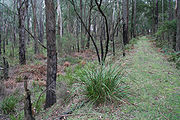
Darjeeling Himalayan Railway
The Darjeeling Himalayan Railway, nicknamed the "Toy Train", is a narrow gauge railway from New Jalpaiguri to Darjeeling in West Bengal, run by the Indian Railways....
in India
India
India , officially the Republic of India , is a country in South Asia. It is the seventh-largest country by geographical area, the second-most populous country with over 1.2 billion people, and the most populous democracy in the world...
and the Ffestiniog railway
Ffestiniog Railway
The Ffestiniog Railway is a narrow gauge heritage railway, located in Gwynedd, Wales. It is a major tourist attraction located mainly within the Snowdonia National Park....
in Wales
Wales
Wales is a country that is part of the United Kingdom and the island of Great Britain, bordered by England to its east and the Atlantic Ocean and Irish Sea to its west. It has a population of three million, and a total area of 20,779 km²...
. An initial decision to build the lines in gauge was changed to gauge for the Victorian lines. This gauge was being adopted on other lines in the British Empire
British Empire
The British Empire comprised the dominions, colonies, protectorates, mandates and other territories ruled or administered by the United Kingdom. It originated with the overseas colonies and trading posts established by England in the late 16th and early 17th centuries. At its height, it was the...
at this time, such as the Kalka-Shimla Railway
Kalka-Shimla Railway
The Kalka–Shimla Railway is a narrow gauge railway in North-West India travelling along a mostly mountainous route from Kalka to Shimla. It is known for breathtaking views of the hills and surrounding villages.- History :...
and the Sierra Leone Government Railway
Sierra Leone Government Railway
The Sierra Leone Government Railway operated in the West African country of Sierra Leone from 1897 to 1974. It was unusual in that it formed a national railway system constructed solely to a rail gauge...
. The railways were constructed using 60 lb/yd rail, initially obtained from broad gauge lines that were being upgraded. A maximum grade of 1 in 30 (3.33%) was adopted, while the minimum radius of curves
Minimum railway curve radius
The minimum railway curve radius, the shortest design radius, has an important bearing on constructions costs and operating costs and, in combination with superelevation in the case of train tracks, determines the maximum safe speed of a curve. Superelevation is not a factor on tramway tracks...
was 2 chain
Chain (unit)
A chain is a unit of length; it measures 66 feet or 22 yards or 100 links . There are 10 chains in a furlong, and 80 chains in one statute mile. An acre is the area of 10 square chains...
s i.e. 132 feet (40 m).
Apart from a couple of experiments with other systems, all lines were operated by the Staff and Ticket
Token (railway signalling)
In railway signalling, a token is a physical object which a locomotive driver is required to have or see before entering onto a particular section of single track. The token is clearly endorsed with the name of the section it belongs to...
method of safeworking
Safeworking
Signalling block systems enable the safe and efficient operation of railways, so as to avoid collisions between trains. Block systems are used to control trains between stations and yards, and not normally within them. Any block system is defined by its associated physical equipment and by the...
, as was standard Victorian Railways practice for this system.
Locomotives and rolling stock
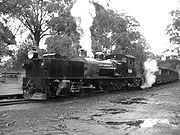
2-6-2
Under the Whyte notation for the classification of steam locomotives, 2-6-2 represents the wheel arrangement of two leading wheels, six coupled driving wheels and two trailing wheels.Other equivalent classifications are:...
tank locomotive
Tank locomotive
A tank locomotive or tank engine is a steam locomotive that carries its water in one or more on-board water tanks, instead of pulling it behind it in a tender. It will most likely also have some kind of bunker to hold the fuel. There are several different types of tank locomotive dependent upon...
s and two Garratt
Garratt
A Garratt is a type of steam locomotive that is articulated in three parts. Its boiler is mounted on the centre frame, and two steam engines are mounted on separate frames, one on each end of the boiler. Articulation permits larger locomotives to negotiate curves and lighter rails that might...
locomotives, plus a range of passenger and goods vehicles, were built to operate on the narrow gauge lines. Six of the locomotives, including one of the Garratt locomotives, as well as at least one example of each type of rolling stock
Rolling stock
Rolling stock comprises all the vehicles that move on a railway. It usually includes both powered and unpowered vehicles, for example locomotives, railroad cars, coaches and wagons...
, have been restored to working order on the Puffing Billy Railway.
Apart from light maintenance that could be done locally, the locomotives and rolling stock were maintained at the Victorian Railways' Newport Workshops
Newport Railway Workshops
The Newport Railway Workshops is a facility in the Melbourne suburb of Newport, Victoria, Australia, that builds, maintains and refurbishes railway rollingstock. It is located between the Williamstown and Werribee railway lines.-History:...
in the suburbs of Melbourne
Melbourne
Melbourne is the capital and most populous city in the state of Victoria, and the second most populous city in Australia. The Melbourne City Centre is the hub of the greater metropolitan area and the Census statistical division—of which "Melbourne" is the common name. As of June 2009, the greater...
, requiring the transport of the vehicles by broad-gauge flat wagons. The locomotives and other vehicles would be moved around the various narrow-gauge lines as appropriate, so that no equipment was dedicated to particular lines. However the G class
Victorian Railways G class
The G class Garratt locomotives were built for the Victorian Railways 2' 6" gauge branch lines. These locomotives were introduced in 1926 to increase train sizes and thus reduce losses on these lines...
Garratts were only used on the Crowes and Walhalla lines, while the NBH excursion coaches remained on the Gembrook line while that line was in operation.
The trains were all fitted with Westinghouse air brakes
Westinghouse Air Brake Company
The railway air brake was invented by George Westinghouse of New York state in 1869. Soon after, he moved to Pittsburgh, Pennsylvania, where he established the Westinghouse Air Brake Company on September 28, 1869...
and, originally, with chopper couplers. In the mid 1920s the couplers were replaced with small MCB , or "knuckle" couplers.
Locomotives
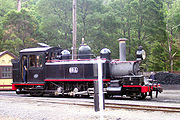
Baldwin Locomotive Works
The Baldwin Locomotive Works was an American builder of railroad locomotives. It was located in Philadelphia, Pennsylvania, originally, and later in nearby Eddystone, Pennsylvania. Although the company was very successful as a producer of steam locomotives, its transition to the production of...
in the United States supplied the first two 2-6-2
2-6-2
Under the Whyte notation for the classification of steam locomotives, 2-6-2 represents the wheel arrangement of two leading wheels, six coupled driving wheels and two trailing wheels.Other equivalent classifications are:...
tank locomotive
Tank locomotive
A tank locomotive or tank engine is a steam locomotive that carries its water in one or more on-board water tanks, instead of pulling it behind it in a tender. It will most likely also have some kind of bunker to hold the fuel. There are several different types of tank locomotive dependent upon...
s, as well as parts for a further two locos. One each of the supplied locos and the parts kits was a simple loco, and the other a compound
Compound locomotive
A compound engine unit is a type of steam engine where steam is expanded in two or more stages.A typical arrangement for a compound engine is that the steam is first expanded in a high-pressure cylinder, then having given up heat and losing pressure, it exhausts directly into one or more larger...
. The new class was classed "A", however confusion with the broad gauge A, AA and A2
Victorian Railways A2 class
The A2 class was an express passenger locomotive that ran on Victorian Railways from 1907 to 1963. A highly successful design entirely the work of Victorian Railways' own design office, its long service life was repeatedly extended as economic depression and war delayed the introduction of more...
classes lead to them being referred to as Narrow-gauge A class for a short while followed by a prefix "N" being applied to written records, making it the NA class
Victorian Railways NA class
The Victorian Railways NA class was a 2-6-2 tank locomotive built for their 2' 6" gauge branch lines.Baldwin Locomotive Works in the United States supplied the first two 2-6-2 tank locomotives, as well as parts for a further two locos. One each of the supplied locos and the parts kits was a...
. The Victorian Railways Newport Workshops
Newport Railway Workshops
The Newport Railway Workshops is a facility in the Melbourne suburb of Newport, Victoria, Australia, that builds, maintains and refurbishes railway rollingstock. It is located between the Williamstown and Werribee railway lines.-History:...
assembled the parts to give an additional two locos, and subsequently built a further 13 of the simple cylinder version. The last one, number 17, was built in 1915.
The locomotives weigh 36 LT (36.6 t; 40.3 ST) and produce a tractive effort
Tractive effort
As used in mechanical engineering, the term tractive force is the pulling or pushing force exerted by a vehicle on another vehicle or object. The term tractive effort is synonymous with tractive force, and is often used in railway engineering to describe the pulling or pushing capability of a...
of 12170 pound-forces (54 kN), allowing them to haul loads of 90 LT (91.4 t; 100.8 ST) up grades of 1 in 30 (3.33%). Nos. 6, 7, 8, 12, and 14 have been restored and operate on the Puffing Billy Railway, and No. 3 is also on the Puffing Billy Railway, awaiting eventual restoration. The remaining locomotives have all been scrapped.
By the mid 1920s, traffic was growing with up to 7 trains a day on the Beech Forest line. To decrease train mileage and therefore costs, two G class
Victorian Railways G class
The G class Garratt locomotives were built for the Victorian Railways 2' 6" gauge branch lines. These locomotives were introduced in 1926 to increase train sizes and thus reduce losses on these lines...
Garratt
Garratt
A Garratt is a type of steam locomotive that is articulated in three parts. Its boiler is mounted on the centre frame, and two steam engines are mounted on separate frames, one on each end of the boiler. Articulation permits larger locomotives to negotiate curves and lighter rails that might...
locomotives were purchased from Beyer-Peacock
Beyer-Peacock
Beyer, Peacock and Company was an English railway Locomotive manufacturer with a factory in Gorton, Manchester. Founded by Charles Beyer and Richard Peacock, it traded from 1854 until 1966...
in England. Weighing 69 tons (70.1 t), these 2-6-0+0-6-2
2-6-0+0-6-2
In the Whyte notation for the classification of steam locomotives by wheel arrangement, a 2-6-0+0-6-2 is a Garratt articulated locomotive using a pair of 2-6-0 power units back to back, with the boiler and cab suspended between them...
locomotives produce a tractive effort of 26860 pound-forces (119 kN), making them among the most powerful steam locomotives ever built for gauge. They were designated as the "G" class and given the numbers 41 and 42, and entered service in 1926. G41 spent its entire life on the Crowes line, whilst G42 was originally allocated to the Walhalla line, then transferred to the Crowes line, and is currently running on the Puffing Billy Railway. G41 was scrapped, after having been extensively cannibalised for parts to keep G42 running in the last years of the Crowes line.
Rolling stock

Broad gauge
Broad-gauge railways use a track gauge greater than the standard gauge of .- List :For list see: List of broad gauges, by gauge and country- History :...
goods vehicles of the time were 4 wheel wagons, all the narrow gauge rolling stock
Rolling stock
Rolling stock comprises all the vehicles that move on a railway. It usually includes both powered and unpowered vehicles, for example locomotives, railroad cars, coaches and wagons...
were bogie
Bogie
A bogie is a wheeled wagon or trolley. In mechanics terms, a bogie is a chassis or framework carrying wheels, attached to a vehicle. It can be fixed in place, as on a cargo truck, mounted on a swivel, as on a railway carriage/car or locomotive, or sprung as in the suspension of a caterpillar...
vehicles and most were built on a standard underframe.
The initial stock were all built on a 27 in 4 in (8,331.2 mm) long underframe, with the coaches being the open saloon type with balconies for end loading. Various vans were supplied together with stock cars, but the predominant goods vehicle was the NQR class open truck, of which 218 were eventually supplied. Later some 31 in 4 in (9,550.4 mm) side opening coaches were built to cope with increasing traffic. A number of simple open-sided coaches were also provided for excursion traffic on the Gembrook line.
Wangaratta to Whitfield
The first line, from Wangaratta to Whitfield, was unlike the other lines in that it was built through mostly flat, open, agricultural country, following the King RiverKing River (Victoria)
King River is a river in Victoria, a state of Australia. It is a tributary of the Ovens River and ultimately the Murray River on the western slopes of the Australian Alps. The King Valley is a beautiful, cool climate wine grape growing area. It is a river used by kayaking enthusiasts with many...
. The 30.5 miles (49.1 km) line was built as a narrow-gauge line because it was thought that it might be extended into the mountainous country to the south, but this extension never happened. The line was opened in March 1899, and was the first line to close, in October 1953. The line relied mostly on local agricultural traffic, and opened with a daily mixed train
Mixed train
A mixed train is a train that hauls both passenger and freight cars or wagons. In the early days of railways they were quite common, but by the 20th century they were largely confined to branch lines with little traffic. As the trains provided passengers with very slow service, mixed trains have...
. By the 1930s this had been reduced to a weekly goods service, and stayed at this level until the railway closed. There was only one lineside industry, a dairy at Moyhu, and the majority of stations were nameboards at road crossings.
List of stations
- Wangaratta (Junction station with broad gauge.)
- Targoora
- Laceby
- Oxley
- Skehan
- Docker
- Byrne
- Moyhu
- Angleside
- Claremont
- Dwyer
- Edi
- Hyem
- King Valley
- Jarrott
- Pieper
- Whitfield
Upper Ferntree Gully to Gembrook
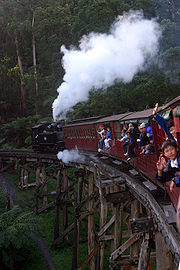
Gembrook, Victoria
Gembrook is a town in Victoria, Australia, 54 km south-east from Melbourne's central business district. Its Local Government Area is the Shire of Cardinia...
line opened in December 1900, through the southern foothills of the Dandenong Ranges
Dandenong Ranges
The Dandenong Ranges are a set of low mountain ranges, rising to 633 metres at Mount Dandenong, approximately 35 km east of Melbourne, Victoria, Australia...
just east of Melbourne. It was closed in 1954 following a landslide between Selby
Selby railway station
Selby railway station serves the town of Selby in North Yorkshire, England. The station is on the Hull-York Line south of York, Leeds-Hull Line east of Leeds and west of Hull....
and Menzies Creek, but continued to operate tourist services for the Puffing Billy Preservation Society over the remaining usable section of the line to Belgrave. However, this came to an end in 1958 when the line was closed to allow conversion
Gauge conversion
In rail transport, gauge conversion is the process of converting a railway from one rail gauge to another, through the alteration of the railway tracks...
to a broad gauge electric line as an extension of the suburban railway system of Melbourne
Railways in Melbourne
The Melbourne rail network is operated by Metro Trains Melbourne under franchise from the Government of Victoria. The network is based on a commuter rail model centred on the Melbourne Central Business District and Flinders Street Station, rather than a rapid transit model, with a focus on...
. Through the efforts of the Puffing Billy Preservation Society, the landslide was bypassed and the remainder of the line from Belgrave to Gembrook has been restored and operates daily for tourists. The railway is now administered by the Emerald Tourist Railway Board.
The Gembrook line always had a higher passenger loading than the other lines. The junction station of Upper Ferntree Gully was a terminus for the Melbourne
Melbourne
Melbourne is the capital and most populous city in the state of Victoria, and the second most populous city in Australia. The Melbourne City Centre is the hub of the greater metropolitan area and the Census statistical division—of which "Melbourne" is the common name. As of June 2009, the greater...
suburban rail system, so the line was popular with weekend visitors from Melbourne. Fifteen special excursion
Excursion
An excursion is a trip by a group of people, usually made for leisure, education, or physical purposes. It is often an adjunct to a longer journey or visit to a place, sometimes for other purposes....
coaches classed NBH were built to cater for this traffic. Travelling through a region with rich soils and high rainfall, agricultural products such as potatoes formed much of the freight traffic. Nobelius Nurseries over the years dispatched thousands of fruit tree
Fruit tree
A fruit tree is a tree which bears fruit that is consumed or used by people — all trees that are flowering plants produce fruit, which are the ripened ovaries of flowers containing one or more seeds. In horticultural usage, the term 'fruit tree' is limited to those that provide fruit for...
s from a packing shed located on Nobelius siding, between Emerald and Nobelius stations. Sawn timber was also important, and sidings were located at Gembrook to serve several private and gauge tramways that brought timber down from further up the mountains.
List of stations
- Upper Ferntree Gully (Junction station with broad gauge.)
- UpweyUpwey railway station, MelbourneUpwey is a railway station in Melbourne, Victoria, Australia, located in the suburb of Upwey, on the Belgrave railway line. Upwey is unstaffed and is in Metcard Zone 2.-Facilities:...
- Tecoma
- Belgrave
- SelbySelby railway station, MelbourneSelby Station was opened in May 1904, and named after the local landowner and Shire President W. Selby. The station consists of a short platform and corrugated iron waiting shelter. Trains do not normally stop here, but will stop if required....
- Menzies Creek
- Clematis
- Emerald
- Nobelius
- LakesideLakeside railway station, MelbourneFor the station in the Lake District, United Kingdom, see Lakeside railway station, EnglandLakeside Station is situated on the Puffing Billy Railway in Melbourne, Australia. It was opened in 1944 to serve Emerald Lake Park, the popular picnic and recreation reserve opened during World War II...
(Emerald Lake) - Wright
- Cockatoo
- Fielder
- GembrookGembrook railway station, MelbourneGembrook Station is located in the township of Gembrook, and is the terminus of the Puffing Billy Railway.It was opened with the line on 18 December 1900. The railway was rebuilt to here in 1998. Now the trains stop at a new "Town" platform located on the site of a former siding. The original...
Colac to Beech Forest and Crowes

Colac, Victoria
Colac is a small city located in the Western District of Victoria, Australia, situated approximately 150 kilometres south-west of Melbourne on the southern shore of Lake Colac and the surrounding volcanic plains, approximately 40 km inland from Bass Strait. Colac is the largest city in and...
to Beech Forest opened in March 1902, and it was extended to Crowes in June 1911. Nearly 44 miles (70.8 km) long, this was the longest of the narrow gauge lines. It was also the last to close, finally succumbing in June 1962, although the line had been truncated in 1954.
Both the Colac and Crowes lines entered Beech Forest yard from the same end, creating a junction. Trains had to be turned to run down the Crowes branch and a balloon loop was provided at the other end of the yard. A tennis court occupied the land within the loop. Crowes, the terminus of the line, was the most southerly railway station on the Australian mainland.
The primary traffic was sawn timber
Timber
Timber may refer to:* Timber, a term common in the United Kingdom and Australia for wood materials * Timber, Oregon, an unincorporated community in the U.S...
and firewood
Firewood
Firewood is any wood-like material that is gathered and used for fuel. Generally, firewood is not highly processed and is in some sort of recognizable log or branch form....
, with many sawmill
Sawmill
A sawmill is a facility where logs are cut into boards.-Sawmill process:A sawmill's basic operation is much like those of hundreds of years ago; a log enters on one end and dimensional lumber exits on the other end....
s located adjacent to the railway, or accessed by short tramways. Seasonally heavy potato
Potato
The potato is a starchy, tuberous crop from the perennial Solanum tuberosum of the Solanaceae family . The word potato may refer to the plant itself as well as the edible tuber. In the region of the Andes, there are some other closely related cultivated potato species...
traffic and a lime kiln added to revenue. Traffic grew to require up to 7 trains a day each way by the mid 1920s. The introduction of the Garratt
Garratt
A Garratt is a type of steam locomotive that is articulated in three parts. Its boiler is mounted on the centre frame, and two steam engines are mounted on separate frames, one on each end of the boiler. Articulation permits larger locomotives to negotiate curves and lighter rails that might...
locomotive allowed a new timetable with two trains each way between Colac and Beech Forest, and a third train each way to Gellibrand. The Crowes branch saw a single mixed train daily. The arrival of the Great Depression
Great Depression
The Great Depression was a severe worldwide economic depression in the decade preceding World War II. The timing of the Great Depression varied across nations, but in most countries it started in about 1929 and lasted until the late 1930s or early 1940s...
and competition from motor vehicles saw traffic decline to a point where only one train each way operated over the line three days a week. Increased wartime
World War II
World War II, or the Second World War , was a global conflict lasting from 1939 to 1945, involving most of the world's nations—including all of the great powers—eventually forming two opposing military alliances: the Allies and the Axis...
loadings saw traffic increase to two trains each way daily, however this improvement was only temporary. By the time the railway closed, the timetable listed only one train each way a week, and most of the traffic was pulpwood
Pulpwood
Pulpwood refers to timber with the principal use of making wood pulp for paper production.-Applications:* Trees raised specifically for pulp production account for 16% of world pulp production, old growth forests 9% and second- and third- and more generation forests account for the balance...
.
The line opened using the Staff and Ticket method of safeworking. However Train Section Orders were adopted between 1927 and 1939, after which Staff and Ticket working was resumed.
List of stations
- ColacColac railway station, VictoriaColac is a railway station in Colac, Victoria, Australia. It is serviced by V/Line passenger trains on the Warrnambool line, with all services stopping here. Goods facilities included a brick goods shed, and a steel shelter provided with the freight gate during the 1980s...
(Junction station with broad gauge.) - Eliminyt
- Tulloh
- Coram
- Barongarook
- Birnam
- Kawarren
- Lovat
- Gellibrand
- Banool
- Wimba
- Dinmont
- Ditchley
- Beech Forest (Terminus until 1911)
- Buchanan
- Ferguson
- Weeaproinah (Terminus from 1955)
- Kincaid
- Wyelangta
- Stalker
- Macknott
- Lavers HillLavers Hill, VictoriaLavers Hill is a town in Victoria, Australia, located inland from Port Campbell and from Apollo Bay. The township is located approximately south-west of the state capital, Melbourne. At the 2006 census, Lavers Hill had a population of 208.- History :...
- Crowes
Moe to Walhalla
The last of the narrow gauge lines to open was the 26 miles (41.8 km) line to the gold miningGold mining
Gold mining is the removal of gold from the ground. There are several techniques and processes by which gold may be extracted from the earth.-History:...
town of Walhalla
Walhalla, Victoria
Walhalla is a small town in Victoria, Australia, founded as a gold-mining community in early 1863 and at its peak home to around 2,500 residents. Today, the town has a population of fewer than 20 permanent residents, though it has a large proportion of houses owned as holiday properties. It...
, in 1910. Walhalla had a history of gold mining dating back to the 1870s, and was one of the largest towns in Gippsland
Gippsland
Gippsland is a large rural region in Victoria, Australia. It begins immediately east of the suburbs of Melbourne and stretches to the New South Wales border, lying between the Great Dividing Range to the north and Bass Strait to the south...
. Local residents had long lobbied for a railway, as all goods had to be brought in by bullock cart
Bullock cart
A bullock cart or ox cart is a two-wheeled vehicle pulled by oxen . It is a means of transportation used since ancient times in many parts of the world. They are still used today where modern vehicles are too expensive or the infrastructure does not favor them.Used especially for carrying goods,...
over rough terrain. However, the gold mine in Walhalla closed in 1914, and the town quickly fell into steep decline. It was reputed that the major source of traffic from Walhalla were the houses of residents leaving the town.
The line did pick up significant traffic from sawmills in the area, some of which had their own sidings. A connection was made with the Tyers Valley Tramway
Tyers Valley Tramway
The Tyers Valley Tramway was a narrow gauge timber tramway built by the Forestry Commission of Victoria to exploit timber resources on the slopes of Mount Baw Baw, Victoria...
at Collins siding, between Watson and Erica. While the tramway used the same gauge as the railway, there was no physical connection, timber being transhipped by hand. A temporary connection had to be put in place to move locomotives to and from the tramway. A small copper mine and two lime kilns near Platina provided additional traffic. A series of "Back to Walhalla" days in the 1930s caused the railways to put on special passenger trains for these occasions, and such was the demand some were double-headed.
The line was truncated to Platina in 1944 then to Erica in 1952, before finally closing in 1954. The section of the line from Thomson to Walhalla has been rebuilt and now operates as the Walhalla Goldfields Railway
Walhalla Goldfields Railway
The Walhalla Goldfields Railway is a gauge tourist railway located in the Thomson River and Stringers Creek valleys in Gippsland, Victoria, Australia, near the former gold-mining town and tourist destination of Walhalla.- History :...
.
List of stations
- Moe (Junction station with broad gauge.)
- Gooding
- Temporary Station Site
- Tyers River
- Gould
- Moondarra
- Watson
- Erica (Terminus from 1952)
- Murie
- Platina (Terminus from 1944)
- Thomson (Temporary terminus, closed with opening of Walhalla)
- Walhalla
Welshpool to Port Welshpool horse-drawn tram
Unlike the other lines, the 3 miles (4.8 km) line connecting WelshpoolWelshpool, Victoria
Welshpool is a town in the South Gippsland region of Victoria, Australia. At the 2006 census, Welshpool had a population of 147.-Notes and references:...
and Port Welshpool
Port Welshpool, Victoria
Port Welshpool is a town in the South Gippsland region of Victoria, Australia. It is located 191km south-east of Melbourne, on Corner Inlet and in 2006 had a population of 191.-External links:* *...
was operated as a horse-drawn tramway, and had very little in common with the other lines. This line, also known as the Welshpool Jetty line, was opened in 1905 and closed in 1941.
External links
Rolling stock:

